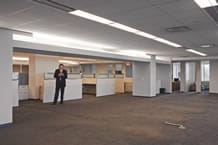From Midtown to Downtown, experts agree: Manhattan’s commercial real estate market is a mess. But are better days ahead?
By Steven Kurutz
 The signs have an almost pleading quality. “SPECTACULAR VIEWS OF HUDSON RIVER, EMPIRE STATE BUILDING AND TIMES SQUARE.” “STATE-OF-THE-ART DESTINATION DISPATCH ELEVATORS.” They hang from a scaffold surrounding 11 Times Square, a 40-story glass-and-steel office tower under construction at the corner of 42nd Street and 8th Avenue in Manhattan. The building, being developed by SJP Properties of Parsippany, NJ at a cost of over $1 billion, is one of the city’s most high-profile recent commercial projects and, befitting the frothy era when the deal was signed, was financed on spec, without lease agreements in place. When 11 Times Square is completed later this year, it will add 1.2 million square feet to Manhattan’s deep pool of office space.
The signs have an almost pleading quality. “SPECTACULAR VIEWS OF HUDSON RIVER, EMPIRE STATE BUILDING AND TIMES SQUARE.” “STATE-OF-THE-ART DESTINATION DISPATCH ELEVATORS.” They hang from a scaffold surrounding 11 Times Square, a 40-story glass-and-steel office tower under construction at the corner of 42nd Street and 8th Avenue in Manhattan. The building, being developed by SJP Properties of Parsippany, NJ at a cost of over $1 billion, is one of the city’s most high-profile recent commercial projects and, befitting the frothy era when the deal was signed, was financed on spec, without lease agreements in place. When 11 Times Square is completed later this year, it will add 1.2 million square feet to Manhattan’s deep pool of office space.
Two years ago, as rents in some neighborhoods approached historic highs of $100 a square foot—reaching even giddier summits in the Plaza District near Central Park—a developer would have swooned over all those crisp new cubicles hitting the market. But the economic winds have shifted. The signs on the scaffold suggest trouble. In fact, the building hasn’t signed a single tenant.
If 11 Times Square is the most visible face of the struggling real estate market, many of the city’s office buildings are facing an equally difficult and uncertain future. The U.S. housing sector and its Depression-like wave of foreclosures tends to steal headlines, but since the financial crisis hit last fall, commercial real estate has suffered its own precipitous nosedive. Vacancy rates nationwide are hovering at 15 percent. In cities heavily reliant on the financial sector, such as Stamford, CT, rates are headed toward 20 percent. In Manhattan, a city whose fortunes are so closely tied to Wall Street, the downturn has been particularly ruthless. In December, Mitchell S. Steir, chief executive at Studley, a national brokerage firm that represents tenants, told The New York Times: “There has been more damage to real estate values in the last four months than in any other four-month period [ever].” Steir called the fall of the market “astonishing.”
Consider the numbers: the current vacancy rate in once-coveted Midtown stands at 15.4 percent, up from 8.7 percent a year ago. By many estimates, as much as 15 million square feet of empty office space sits on the market, a wasteland of cubicles. Rents have dropped 30 percent or more in many neighborhoods since peaking at $86.50 per square foot last August—and they’re likely to drop even further. “These are not good numbers,” says Joseph Gyourko, Martin Bucksbaum Professor of Real Estate and Finance at Wharton and director of the Sam Zell and Robert Lurie Real Estate Center. “When you see vacancy rates above 10 percent, the industry is struggling.”
With companies in full-on cost-cutting mode and economists predicting a jobless recovery, few firms are looking to lease new office space. “In the last eight months, it’s been as dead as I’ve ever seen it,” says Michael Colacino, president of Studley and member of the Zell/Lurie Center advisory board. People are also invoking comparisons to the early ‘90s, when the combination of years of overbuilding and a deep recession kept the Manhattan commercial market in a quagmire for half a decade. During that downturn, vacancy rates hit 20 percent. “My feeling,” says Lewis Miller, W’85, WG’85, a vice chairman at CB Richard Ellis, “is that this is every bit as bad as the early ‘90s.”
To get a sense of how soft the market is, Miller suggests examining factors beyond falling rents—namely, landlord concessions. Like TV infomercial pitchmen, owners are bending over backward to sweeten deals, offering tenants longer periods of free rent, more money toward construction costs and relaxed subleasing agreements. “If you factor in the concession packages, rents are probably down 30-50 percent in high-end buildings,” Lewis says. One deal Colacino recently negotiated included 36 months of free rent. He also cited construction allowances from landlords that have hit $70 to $80 a square foot, double the recent industry standard. “It’s historic,”Colacino says. “And I’m not even getting into the crazy landlords. There are guys who are doing more than that.”
If the downturn seems extreme, it’s largely because the run-up was so dizzying. Only a year ago, New York City commanded the highest commercial rents in the country; vacancy rates in Class A buildings hovered around 3 percent. In the Plaza District, where many office towers overlook Central Park, rents reached nearly $200 per square foot, historic numbers fueled by cash-flush hedge funds whose managing partners were charmed by the park views, boutique floor plates and short walks to their East Side manses.
But landlords, after holding out briefly last fall, have acknowledged the sudden turn of fortune and are adjusting, as evidenced by the downward gravitational pull of rents and those sweetheart perks. Such deals may seem foolish, but Colacino says they are often better than incurring the high costs when a tenant moves out, like refurbishing and marketing a space. It’s also preferable to empty offices languishing on the market—a real possibility since owners of raw space are increasingly competing with finished (and therefore cheaper) sublease space offered by companies who have downsized or vacated offices since the recession began. “If you thought everything was going to turn around tomorrow, you’d say, ‘What the heck,’ keep the space and wait for a recovery,” says Gyourko. “But I don’t think many landlords feel that’s the case.”
 On the sale side, the mood among developers is equally downbeat. According to William L. Mack, W’61, Founder and Chairman of AREA Property Partners, which co-developed the Time Warner Center, sale prices that ranged from $500 to $1,200 a square foot during the boom have dipped to the $350 to $500 level—that is, when transactions happen at all. Mack cites only two recent sales in Manhattan of real significance: Worldwide Plaza and the old Bertelsmann building, 1585 Broadway. “The double-hit is rents going down and the perception of rents going down further,” Mack says.
On the sale side, the mood among developers is equally downbeat. According to William L. Mack, W’61, Founder and Chairman of AREA Property Partners, which co-developed the Time Warner Center, sale prices that ranged from $500 to $1,200 a square foot during the boom have dipped to the $350 to $500 level—that is, when transactions happen at all. Mack cites only two recent sales in Manhattan of real significance: Worldwide Plaza and the old Bertelsmann building, 1585 Broadway. “The double-hit is rents going down and the perception of rents going down further,” Mack says.
His advice for office developers? “You should be like Rip Van Winkle and go to sleep for five years. There may be a market when you wake up.”
Storm Clouds on the Horizon
On a recent Tuesday afternoon, Ira Kaufman, W’89, stood inside an office building on lower Broadway, touring empty space with a broker. An attorney who until recently worked at the firm K&L Gates, Kaufman is a tenant representative for commercial leasing. He represents one of the few groups benefiting from the downturn: companies seeking office space.
On this day, he was making the rounds with members of a personal injury law firm whose lease on 7,000 square feet in a nearby building is due to expire. Not surprisingly, Kaufman and his clients are finding the market conditions favorable. At first uncooperative, the firm’s current landlord agreed to lower the rent by 25 percent if they renew the lease. At another time, it would be a can’t-pass deal. Not now. Speaking of the offers he’s hearing about in other buildings, Kaufman says: “We’re able to get a high floor for the same price as a lower floor. Landlords are saying, ‘We will literally build the space for you.’ And these are Class A buildings.”
Kaufman has been counseling clients that if they find a space they like at a good price they should “do the deal now.” But is it possible the market will get worse? Real estate is a lagging indicator, and the securitization that turned the residential market into high-stakes poker occurred in commercial, too. Some believe the effects are only now starting to show. “There will be waves of foreclosures in commercial,” predicts Colacino. “I think there was a lot of bad underwriting going on.” Jonathan Frey, W’88, who worked for Morgan Stanley’s commercial lending group until he was laid off in May, believes proper due diligence took place but says the real problem lies in the valuations. “Commercial properties aren’t worth the level at which the loans were made,” he says.
One prime example is 11 Times Square, where financing was secured with the belief the building would command $100 rents. In May, Steven Pozycki of SJP told the Real Deal magazine he’d accept rents in the $70s, a figure that would still give “a nice yield on the property.” But other developers don’t have that flexibility.
According to Ken McCarthy, managing director of research at Cushman & Wakefield, old-line real estate families like the Dursts and Rudins who didn’t over-leverage can ride out the cycle. But developers who took advantage of easy credit during the peak are, he says, “in a vise.”
There is another storm cloud on the horizon. So far, downtown Manhattan has held up remarkably compared to Midtown, with vacancy rates at 8 percent. But the bloodbath in the financial sector and the industry’s contraction will surely affect the area’s real estate picture. The World Financial Center houses Merrill Lynch, but with the firm’s takeover by Bank of America, Merrill’s continued presence in the building is questionable. One million square feet is already available at 85 Broad Street, the current headquarters of Goldman Sachs, as the firm is set to move into new headquarters on West Street early next year. And firms that survived, like AIG, are hobbled and hardly in expansion mode. When you factor in developer Larry Silverstein’s on again/off again World Trade Center project, it could increase available space in the neighborhood by several million square feet. “Jobs create the need for space,” says Mack. “There’s a big question as to what will take the financial industry’s place, if it doesn’t come back.”
Better Days Ahead?
Each day, Colacino analyzes rental data in search of a telling figure—how much new space is coming on the market daily. There was a period earlier this year when the number hit 200,000 square feet. That’s a million square feet per week. Currently, Colacino says, the number is around 50,000. “In six months or a year from now when that space is absorbed,” he says, “we’ll see rents going up again.”
And that turnaround might not be all that far off. Amid all the bad news, there are some positive signs that the downturn is slowing, if not quite over. Miller of CB Richard Ellis says June was the first month in more than a year that saw more than one million square feet of leasing activity in Midtown. It could be a dead-cat bounce—a figure inflated by firms whose leases were up in the fall but put off moving in the thick of the financial crisis—but it’s also possible the market has found a bottom, and is stabilizing, as companies take tentative steps forward. The fact that the recent boom was too short to allow for the same kind of rampant overbuilding that occurred in the early ’90s is also a positive; that sea of empty offices is a result of what Gyourko calls a “negative demand shock,” not a space glut.
Though there is disagreement as to whether another severe shock to the system is looming (perhaps in the form of foreclosures), most industry insiders think a recovery is a year or two away. Everyone agrees on the one thing that will spur it. “Commercial real estate needs the labor market to stabilize growth,” Gyourko says. “Real estate needs bodies.”
Steven Kurutz writes for The Wall Street Journal. This is his first piece for Wharton Magazine.


























